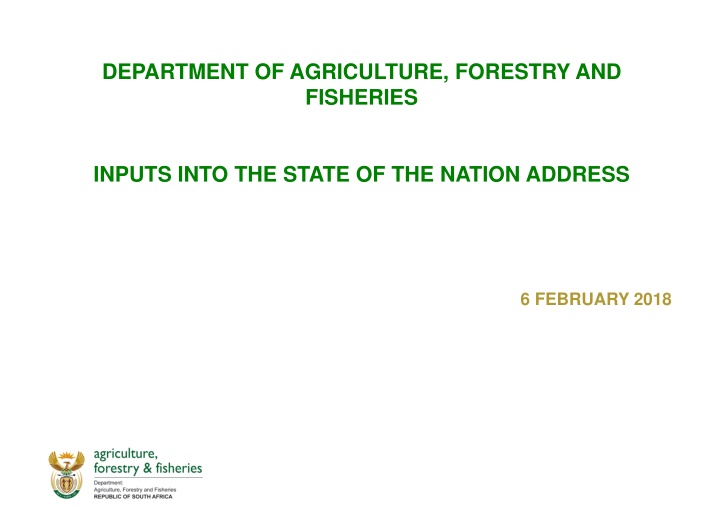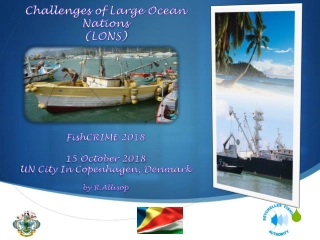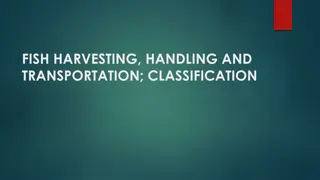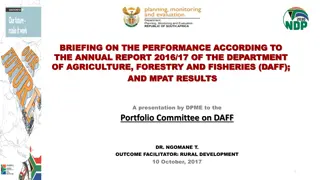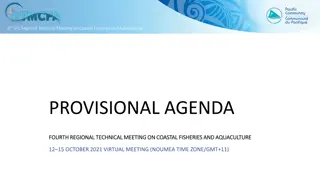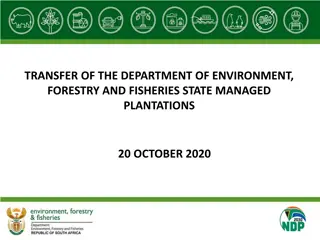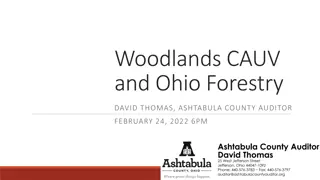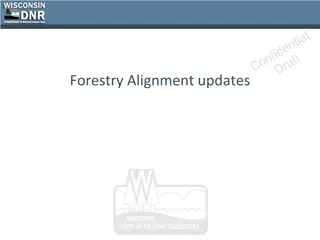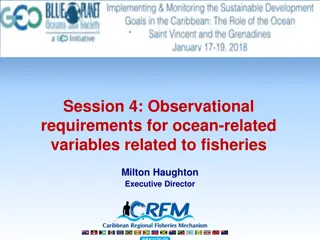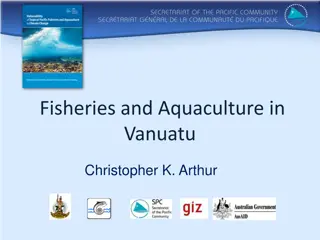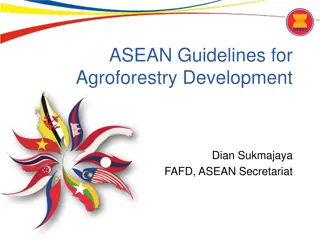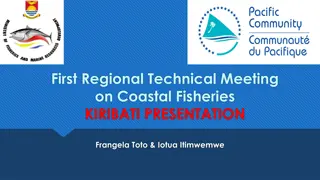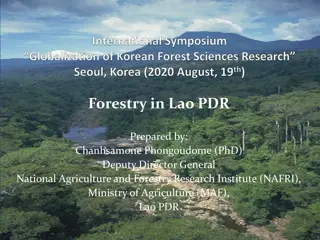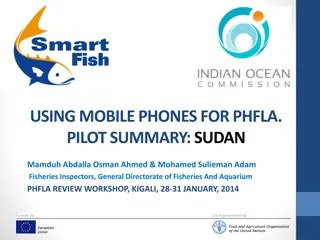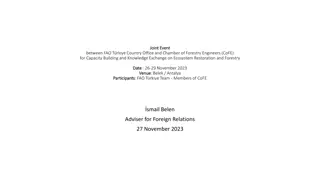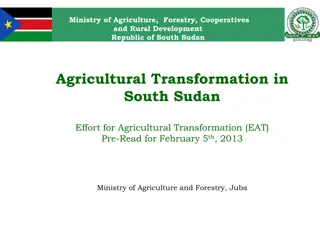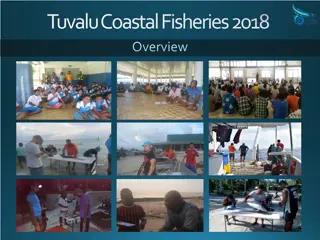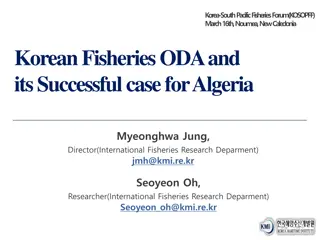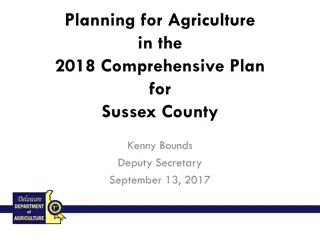Agriculture, Forestry, and Fisheries: State of the Nation Address 2018 Review
The Department of Agriculture, Forestry, and Fisheries presented insights into the state of the nation in 2018, focusing on the revitalization of the agriculture and agro-processing value chain. Key challenges discussed include land transfer, declining household involvement in agriculture, and input costs for smallholder farmers. Initiatives such as the Revitalization of the Agriculture and Agro-Processing Value Chain and outcomes of the Agri, Land, and Rural Phakisa are highlighted to address these challenges and drive economic development in the sector.
Download Presentation

Please find below an Image/Link to download the presentation.
The content on the website is provided AS IS for your information and personal use only. It may not be sold, licensed, or shared on other websites without obtaining consent from the author.If you encounter any issues during the download, it is possible that the publisher has removed the file from their server.
You are allowed to download the files provided on this website for personal or commercial use, subject to the condition that they are used lawfully. All files are the property of their respective owners.
The content on the website is provided AS IS for your information and personal use only. It may not be sold, licensed, or shared on other websites without obtaining consent from the author.
E N D
Presentation Transcript
DEPARTMENT OF AGRICULTURE, FORESTRY AND FISHERIES INPUTS INTO THE STATE OF THE NATION ADDRESS 6 FEBRUARY 2018
TABLE OF CONTENTS Revitalization of the Agriculture and Agro-Processing Value Chain (RAAVC) Revitalization of the Agriculture and Agro-Processing Value Chain (RAAVC) Outcomes of Agri, Land and Rural Phakisa Revitalization of the Agriculture and Agro-Processing Value Chain (RAAVC) Initiatives Key messages for SONA - Revitalization of the Agriculture and Agro-Processing Value Chain (RAAVC) Economic Development, Trade and Marketing Economic Development, Trade and Marketing Export Priorities NDP- Prioritize high growth and labour intensive industries Phytosanitary Priorities/ Action Plan on Fruit Market Access Forestry and Natural Resources Management Agricultural Graduate Placement Programme Biosecurity Fisheries 2
Revitalization of the Agriculture and Agro-Processing Value Chain (RAAVC) Introduction According to Stats SA, employment in the agricultural sector increased by 32% between 2012 and 2016, however as a result of the drought conditions, Agriculture shed a total of 109 000 jobs over 3 consecutive quarters. Despite these job losses, the share of households experiencing hunger over the past 15 years declined by more than half, and the number of individuals experiencing hunger decreased from 29,3% to 13,4% since 2012. There has also been further growth investment and agro-processing sales at 8% and 37% respectively. With such extraordinary performance under very difficult environmental conditions, we believe that Agriculture has shown great resilience, showcasing the potential we are committed to unlock. Key challenges to be addressed: the fact that only eight million hectares of land have been transferred to black people (9.8% of the 82 million hectares of land in South Africa); there has been a 19% decline in households involved in agriculture (from 2.9 million in 2011 to 2.3 million households in 2016); and Input costs such as fertiliser feed and mechanisation serves as a constraint for many small holder farmers. 3
Revitalization of the Agriculture and Agro-Processing Value Chain (RAAVC) Outcomes of Agri, Land and Rural Phakisa The outcomes of the Agri, Land and Rural Phakisa Transforming the Agricultural Sector towards an Inclusive Rural Economy , is the official theme of Operation Phakisa for Agriculture, Land Reform and Rural Development. The theme captures critical elements of the National Development Plan. Through this Phakisa, a total of 161 stakeholders including sector organisations, farmer unions, business, civil society, labour unions and government developed a detailed implementation plan aimed at creating a prosperous and transformed Agricultural Sector. It highlights that true reconciliation will be nearly impossible to achieve if economic inclusion and the land question are not addressed. The initiatives emanating out of the Agriculture, Land Reform and Rural Development Phakisa will now inform the Revitalisation of the Agriculture and Agro-Processing Value chain as part of the Nine-Point Plan. 4
Revitalization of the Agriculture and Agro-Processing Value Chain (RAAVC) Initiatives Under Land Reform, the following five key initiatives have been developed: i. ii. iii. Promoting and Protecting the rights of Persons Living under Insecure Tenure; iv. The Accelerated Land Development and Redistribution Initiative; and v. Financial Partnerships for Accelerated and Sustainable Land Reform. District Land Reform Delivery Centres Fast-tracking the Settlement of Outstanding Restitution Claims; 5
Key messages for SONA - Revitalization of the Agriculture and Agro-Processing Value Chain (RAAVC) Key messages for SONA The District Land Reform Delivery Centres will establish local level implementing agents which will ensure that land reform initiatives are designed and implemented in accordance with the specific needs of local economic plans. The Fast-track Settlement of Outstanding Restitution Claims aims to expedite the settlement of 7 419 outstanding claims within the next 2 to 3 years through a delegation of authority to the regions, whilst simultaneously ensuring better post-settlement performance and governance of restitution projects. The establishment of a Rural Development Agency to mobilise, co-ordinate and manage resources; finance rural development projects; and, coach and train participating co-operatives in business and managerial skills . 6
Key messages for SONA: Revitalization of the Agriculture and Agro-Processing Value Chain (RAAVC) The Accelerated Land Development and Redistribution Initiative which will facilitate the design and development of serviced land and provision of bulk infrastructure services in conjunction with local municipalities, commercial banks, development finance institutions and private sector land developers. For Horticulture, initiatives are focused on expanding the potential for trade in both domestic and export markets, developing and strengthening our value chains, sharpening our research and innovation systems, and making the most of our limited water resources. Three initiatives were developed for Horticulture, one of which is called Trade Promotion, Retention and Optimisation initiative. This initiative aims to increase South Africa s Horticultural trade potential from an estimated R54.4 billion in 2015 to R90 billion by 2030. 7
Key messages for SONA - Revitalization of the Agriculture and Agro-Processing Value Chain (RAAVC) For Livestock, it is necessary to address the need for a national livestock census, and an animal identification and traceability system to strengthen meat exports, improve disease control mechanisms and ultimately ensure adherence to international trade protocols. For Grains initiatives include Unlocking Finance for Grains through Private Public Partnerships. This initiative attempts to address the limited impact grant based financial models are having on growth in the Grain industry. This initiative will link farmers to buyers and processors of grain using contractual innovations which mitigate the risks for both parties. 8
Key messages for SONA - Revitalization of the Agriculture and Agro-Processing Value Chain (RAAVC) The greatest challenge raised by farmers is the poor financial support within the sector for small business including smallholder farmers. The Re-engineering Agricultural Development Finance will develop blended financial products from public and private funds to lessen the current reliance on grant funds. The financial products will be designed to cover both long and medium term loans for buying farms, equipment and machinery, as well as short term loans for production inputs. The new blended financial products will consist of a grant component from government, and a loan component from commercial banks, DFI s and other financiers. It is believed that through the Public Private Partnerships created in the Agriculture, Land Reform and Rural Development Phakisa, that growth constraints in the sector could be unlocked. 9
Economic Development, Trade and Marketing The Department has made great strides to promote cooperation between government and industry and key stakeholders on commodity value chain platforms, which also form part of the Phakisa initiatives. RAAVC (the Revitalization of Agricultural and Agro-processing Value Chain) which is part of and the Nine-Point Plan was to revitalize the agricultural value chain. Phakisa initiatives are an integral part of the acceleration of priority issues, especially for Horticulture trade and market access. The Department has completed two studies in 2015/16 and 2016/17 on international priority market opportunities for the fruit and nuts as well as the vegetables industries. The meat industry is close to finalization in the 2017/18 year and the fish industry is for the coming year 2018/19. Within the various industry value chains evidence based action plans are developed and implemented by government and industry. 10
Economic Development, Trade and Marketing Export Priorities Vegetable Industry Export Priorities A full export priority study was done and a consultative workshop with industry stakeholders was concluded in March 2017 and a way forward was developed. A formal value chain Round Table was formed and will be operational in 2018 to work on an action plan. Meat Industry Export Priorities A full export priority study will be concluded in March 2018 with a proposed consultative and information exchange workshop with importers and exporters. The meat industry forum/s with government will act as a platform to refine an action plan for execution and monitoring. Government take as basis the animal heath and veterinary market access orientated priorities formulated in December 2015 as the basis for verification and improvement. Fish Industry Export Priorities Within the context of the existing value chain round table, further work will be done in 2018/19 to improve and refine export market priorities. Key message for SONA The purpose of an export-led development approach is focus on industry with a high job-multiplier such as the fruit industry (reference NDP slide) 11
Phytosanitary Priorities/ Action Plan on Fruit Market Access o China market access for pears; the protocol for citrus must be changed o South Korea market access for table grapes o Japan market access for avocado s; the protocol for citrus and table grapes must be changed o Thailand market access for apples o EU FCM; CBS (problems related to certain diseases to be solved) o USA market access avocado; the protocol for citrus to be changed o Vietnam market access for oranges and table grapes o Philippines market access for citrus o India cold treatment o Russia pest list 13
Action plan on fruit market access (summary) Sanitary India Tariffs India USA (within the AGOA context or future agreements) EU UK transitional arrangements Awareness / trade pavilions and marketing Indonesia Japan China Political Indonesia 14
Forestry and Natural Resources Management Agroforestry promotes multiple land use and addresses the issue of competing land use between agriculture and forestry. A strategy was piloted in Limpopo and Mpumalanga for the financial year 2017/18. Plans are in place to roll out the implementation to cover KwaZulu-Natal and the Eastern Cape Provinces. DAFF is committed to support farmers with plans to determine infrastructural support. Key message for SONA Key message for SONA 5552.7ha has been rehabilitated through the Land Care Programme which subsequently created 429 jobs. 15
Forestry and Natural Resources Management DAFF is developing a Climate Smart Agricultural Strategic Framework to the sector in the implementation of climate smart agriculture practices. Key message for SONA The framework will enhance resilience of agricultural and food production systems to reduce risk and vulnerability. An irrigation project will be revitalized at Vaalharts Irrigation Scheme in the Northern Cape Province. The Water Research Commission will be co-funded to increase water usage efficiency in the irrigation sector. Tower Gardens will be constructed in the urban areas to improve socio- economic conditions at household level. 16
Agricultural Graduate Placement Programme DAFF has developed an Agricultural Graduate Placement Programme which will commence with implementation during the 2018/19 financial year. The objectives of the programme includes but not limited to the following: o Provide unemployed agricultural, forestry and fisheries graduate with opportunities to gain on-the job experience; o Contribute to accelerated food production through development of a pool of competent young producers; o Bridge the gap of ageing producers and reduce unemployment and poverty among youth; o Provide a platform for active participation of youth in the agriculture, forestry and fisheries value chain; and o Create an enabling environment to support the establishment of youth owned and/or managed enterprises, youth entrepreneurs by linking participants with potential entities that support development of entrepreneurs. Key message for SONA It is envisaged that one thousand unemployed agricultural graduates will benefit from this initiative. 17
BIOSECURITY Context: The opening of international markets in 1994, has led to increased exports and imports of agricultural products, as well as increased movement of goods and people. Thus, there is a need for increased vigilance for possible introductions of animal and plant pests and diseases and other undesirable unsafe food and feed including agricultural remedies. The introduction of new pest and diseases and the poor or inadequate management of those pests and diseases present in the country have the capacity to cripple the agricultural sector especially through its impact on trade. Effective Biosecurity & Biosafety measures contribute to the reduction and prevention, as appropriate, of pest and disease incidence. 18
BIOSECURITY Key messages in SONA: Improving capacity at Ports of Entry (land borders, airports and seaports) to ensure that SA is bio-secured against diseases and quarantine pests; Urging agricultural industry to collaborate with DAFF in achieving this goal of a biosecure SA; Improving food safety in partnership with Department of Health by conducting pesticides residue monitoring and testing; Streamlining business processes in the application and issuance of permits for agricultural products by implementing an Electronic Certification System. 19
FISHERIES MANAGEMENT Aquaculture catalysts projects Aquaculture has been included in the Oceans Economy Operation Phakisa. A total of 8 initiatives in Aquaculture were identified to spur the growth of the sector. One initiative is the selection and implementation of 24 catalysts projects across the country by 2019. Together with the other initiatives, these projects are expected to grow the size of the Aquaculture sector from approximately R700 million to almost R3 billion by 2019, increase production from about 6000 tons in 2013 to approximately 20 000 tons in 2019 and create 500 direct new jobs and also 15 000 jobs in value chain over the same period. Fish farms have been identified for support since 2013 and 49 have been supported for the past 4 years and 4 more fish farms will be supported in the 2018/19. Aquaculture Bill The development of the Bill was also identified as an enabler by the Oceans Economy Operation Phakisa. The Bill was thoroughly consulted through the relevant structures and will be submitted to Parliament for approval in 2018/19. 20
Inland Fisheries Policy The DAFF is developing an inland fisheries policy that is due to go through stakeholder consultation in March-April 2018. South African inland fisheries resources have the potential to contribute to food security, job creation and economic development. However, the lack a national policy to guide their sustainable utilization and development has hampered the development of the sector. While access to other public resources such as marine fisheries, minerals, water and land have thus far been subject to democratic era reform, inland fisheries have been overlooked. This policy is thus designed to align inland fishery governance with Constitutional requirements for a sustainable development approach to natural resource utilization for the benefit of all citizens. 21
